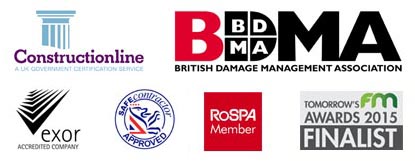February 2013 – Bad for Business – As featured in Tomorrow’s FM February 2013
Alan Lewin, Business Development Director of ServiceMaster Clean, emphasises the importance of acting quickly to remove graffiti and bring defaced property back to its best.
Graffiti can be seen everywhere – in shopping centre facilities, on the walls and doors of commercial businesses, factories and healthcare organisations – and it is estimated that it costs the UK over £1billion per year to clean up.
Illegal under the Criminal Damage Act (1971). graffiti is most common in cities, damaging the appearance of buildings and draining commercial resources. Removal can be costly. According to the British Transport Police, it costs the London Underground an estimated £1O million per annum to replace all the glass that is etched as well as the £2.5million required to clear up other types of graffiti.
Graffiti can cause damage to decorative or delicate surfaces. Affected areas may also start to f eel run down and appear threatening, putting off customers and prospects. Some graffiti ca n be very offensive, threatening to groups or individuals, or racially abusive. Local authorities are not responsible for clearing graffiti on private property, which includes business premises, but will work with the community to prevent graffiti wherever they can.
Art or crime?
There is public debate over whether graffiti should be considered art or crime. Research shows that people make a distinction between vandalism and community projects or genuine street art, best known through
Banksy. Although the public profess a liking for urban art, it is worth pointing out that actual examples are very rarely encountered by those surveying the state of cleanliness in England.
Act fast
First impressions count and an unsightly building could lead to a loss of business or a reduction in staff morale. Eliminating graffiti as soon as it appears makes it easier to remove and reduces the risk
of vandals doing it again. Using a damage management company is the best way to return back to “business as usual.’ Specialists can start putting the property back to normal following not only malicious damage, such as graffiti, but also other forms of unexpected building da mage such as flood, water or fire. You should appoint a contractor that is a member of the British Damage Management Association (BDMA]. This will show that the provider adheres to professional standards, compatible with loss adjuster and insurer processes. ServiceMaster Clean is a founder member and currently has more BDMA accredited senior technicians than any other company in the UK industry. ServiceMaster Clean provides a specialist service, Restoration Response™, which guarantees fast response within a few hours of an emergency to start getting the property back to pre -damage condition. Registration is free so that, if an unexpected emergency occurs, help can quickly be provided. Customers registered to the scheme are guaranteed on -site service within two to four hours.
Graffiti removal
Whether graffiti is on a small or large scale, using the correct products and techniques is vital in its removal and prevention. Common techniques for graffiti removal include painting, sanding, scraping, disinfectants, chemical graffiti removers, power washing, abrasive blasting and graffiti removal gel.
You will also need to consider the actual structure of the area affected and the surface material. You should always seek expert advice as using chemicals or a pressure washer to remove graffiti can damage surfaces further if not used correctly.
Natural deterrents such as Landscaping with shrubs or thorny plants can help to restrict Vandal access, as can fencing and controlled entrances and exits. Limit access to roofs by moving bins away from walls and covering drainpipes to prevent vandals from scaling them. Consider using uneven wall surfaces like pebble dashing or flint work and install security lighting and CCTV cameras.


